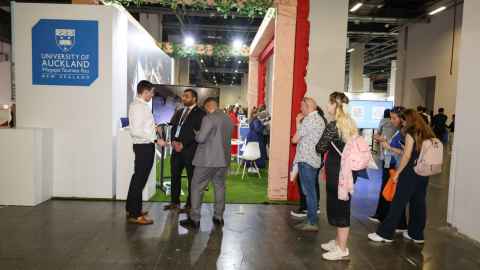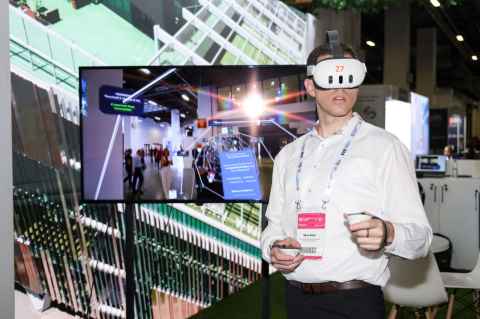Te Ahi Hangarau Tech Hub stars on global stage
19 June 2025
The University of Auckland’s unique experiential learning opportunities were on show at the Global Sustainable Development Congress in Türkiye.

Billed as a global call to action, the Global Sustainable Development Congress brings together the world’s leading thinkers, innovators and policymakers from over 90 countries with the objective of accelerating progress on the United Nations’ Sustainable Development Goals.
Significantly, it also provides a global stage on which more than 1,000 universities, governments, businesses and organisations showcase their leadership in sustainable development – and at last year’s Congress Waipapa Taumata Rau, the University of Auckland, delivered a standout performance. Out of the more than 150 global exhibitors, the University’s exhibition booth was unique in offering delegates the opportunity to experience virtual and mixed reality technology developed across the University, using Te Ahi Hangarau Technology Hub’s Meta Quest 3 headsets and expertise.
“It was quite brave to attempt this – and it was very well-received,” recalls Sean Kelly, Technology and Prototyping Manager at the Business School’s Centre for Innovation and Entrepreneurship (CIE). “We had amazing returns in terms of engaging the delegates.”
The experience proved that the University of Auckland, a co-host sponsor of the event in both 2024 and 2025, is not only holding its own in the global tech education and innovation space, but is in fact one of the frontrunners. For this year’s event – which took place in Istanbul, Türkiye, from June 16-19 – the contingent was just as determined to stay ahead of the pack.
“It was important for us to build on what was delivered at last year’s Congress, but also honour our ethos of being paperless and experiential,” says the University’s Congress project lead, Vasso Koutsos.
Replicating last year’s winning formula was a no-brainer, but to keep it fresh Sean lined up some exciting new content to inspire the more than 5,000 sustainability changemakers in attendance. His role leading the VR experiences at the University’s booth leaned into the evangelical as much as the technical.
“I wanted delegates to walk away impressed that we have the ability and the confidence to develop new capabilities with this technology and demonstrate it on a global stage,” he says.
In preparation for the event, Sean worked with the International Office and stakeholders from across the University who are doing research or development in the virtual and mixed reality tech space, helping them to develop experiences in which delegates at the Congress could easily participate. “This was a collaborative effort across academic and professional communities, supported by a project delivery team to showcase our research, our facilities and to demonstrate our commitment towards a sustainable future,” explains Vasso.
One of the VR experiences featured the data visualisation application used in the Department of Information Systems and Operations Management’s research lab, AroAro. Sean worked with Honorary Academic David White to visualise data sets in 3D.
“Delegates were able to choose from a number of data sets, for example a timeline of the universe or different sea levels around New Zealand,” says Sean.
“People then experienced it in mixed reality, which means they were still anchored in their real world. It’s a very powerful technological medium – it takes data out of tables and enables you to interact with it using natural gestures. What participants saw was projected onto the screens at our booth, and other people also saw them using it.”
The tech is designed to be user-friendly, he adds. “They experienced it without barriers. And we could also see what they saw and how they used it.”
This was a key learning from the 2024 Congress, notes Vasso.
I was excited to learn from other delegates about what their universities are doing in the technology space. At the same time, we’ve been doing this for a few years now, so we had a lot of experience to share...”
Sean also worked with Business School researcher Charlotta Windahl and the Centre for E-Research to showcase their flagship project, the XR Tumour Evolution Project (XRTEP), which was developed by the Collaborative Hybrid Futures Team at the University. This innovative interdisciplinary initiative combines cancer research, data science, architecture and extended reality (XR) technologies, using the tech to create a 3D interactive model of tumour evolution based on real patient data collected over nine years.
“It’s a very powerful medical research visualisation tool and workspace,” observes Sean. “People were able to experience a simplified version that highlighted how mixed reality visualisations can help tell our donor’s story and visualise data in new ways that help research, while still allowing us to work collaboratively.”
A biofeedback and meditation application made for another compelling demonstration of the tech. Flowborne VR is a meditative breathwork experience tailored to cultivate a peaceful and serene breathing style. Originally created by psychologists Dr Johannes Blum and Dr Christoph Rockstroh, it’s now being developed by a start-up called Infinity Speaks, co-founded by Alistair Cran from the Business School’s Executive and Professional Development.
“It guides you through belly breathing using a controller on your belly. And as you breathe, it moves you through different tranquil scenes – so it’s about calming the nervous system,” explains Sean. “It was a very interesting experience with a great story behind it.”
Going for bonus points, Sean also used the Meta Quest 3 headsets to highlight distinctive features of the University’s campus as well as its technological capabilities. He added immersive 3D digital twins – including one he created of the Business School’s Toroa Collab Lounge using Matterport, a powerful spatial data platform – to his already impressive lineup.
“Rather than just a 360-degree photo, which is quite static, this was more immersive,” he explains. “People could move around in it to explore iconic or novel parts of the University.”

Knowledge-sharing was a cornerstone of the Congress, and Sean enjoyed the active exchange of insights, expertise and ideas.
“I was excited to learn from other delegates about what their universities are doing in the technology space,” he says. “At the same time, we’ve been doing this for a few years now, so we had a lot of experience to share about how these spaces are leveraged for teaching and learning or research.”
The University exhibit booth design included QR codes to encourage delegates to connect with the University, fostering ongoing collaboration.Vasso was delighted with the success of the exhibition.
“I feel incredibly proud of everyone,” she shares. “We showed up and honoured our Te Ao Māori values, and we were on the world stage actively participating in the conversation to address the climate challenges we face.”
For Sean, the Congress offered an opportunity to not only spotlight the success of Te Ahi Hangarau Tech Hub, but also to inspire other institutions to follow suit – which was, of course, what the Congress was all about.
“Typically, there’s a lot of apprehension about using this sort of technology in the classroom. But if you have a use case to point to, as we have, that encourages another university to attempt it themselves. I wanted to highlight that this technology can be used at scale, and that it is cost-viable for a university to offer this kind of technology education,” he says.
“What we’ve achieved at the Business School is unique. I wanted to celebrate that we’ve given it a shot – and it’s worked.”
Contact:
Questions? Contact the Centre for Innovation and Entrepreneurship for more information.
E: cie@auckland.ac.nz